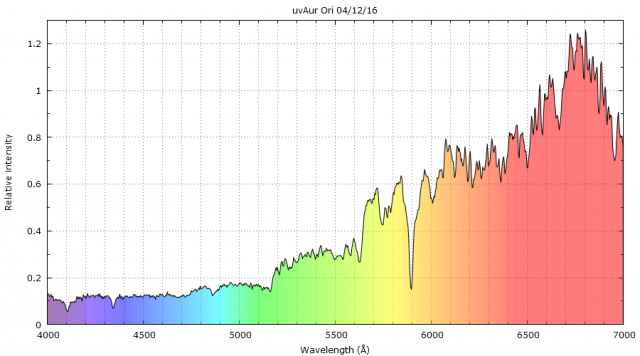› Forums › Spectroscopy › Some symbiotics from last night!
- This topic has 4 replies, 3 voices, and was last updated 9 years ago by
 David Boyd.
David Boyd.
-
AuthorPosts
-
5 December 2016 at 10:14 pm #573644
 Steve CuthbertParticipant
Steve CuthbertParticipantHi folks
Tried a couple of Symbiotic stars last night in between haze and cloud.
Used a new setup for taking flats. Alpha Gem (Castor) an A1V type star used for the response.


Would be useful to know what you think and also choice of star for the response please?.
thanks
Steve
Attachments:
6 December 2016 at 8:36 pm #577706 Andy WilsonKeymaster
Andy WilsonKeymasterHi Steve,
A couple of interesting spectra.
With regard to choice of star for the response, as well as choosing an A or B type star the other factor is to have a good professional spectrum to produce the response curve. Stars from the MILES database are the common choice, as this has good coverage across the sky. In a previous post Robin gave a link to a very useful spreadsheet developed by Paolo Berardi which allows you to search for MILES A or B stars for coordinates of interest.
https://britastro.org/node/8152
I think Castor is a reasonable choice, though Robin and David have more experience in choice of good stars for low resolution spectroscopy than I do. Though it is a double star which might make me think twice about using it, it is in the MILES database (HD060179), so that means there should be a good professional reference spectrum.
Cheers,
Andy
7 December 2016 at 8:08 pm #577723 David BoydParticipant
David BoydParticipantHi Steve,
Your UV Aur spectrum is very similar to one I took of this star back in Feb 2015 which is in the ARAS database at http://www.astrosurf.com/aras/Aras_DataBase/Symbiotics.htm. Looking back at my records, I used HD39357 as a reference star then but today I would check for a suitable Miles star. There are several more recent spectra of the same star in the database so you could download these to compare with your current spectrum.
I haven’t observed V1261 Ori myself but I see there is one recent low resolution spectrum in the ARAS database worth comparing with.
David
9 December 2016 at 8:35 pm #577727 Steve CuthbertParticipant
Steve CuthbertParticipantHi David
Thanks for that, reassuring it was the right star. You think it best to choose a reference star from the Miles database or choose an A or B type near to the target star?.
Steve
9 December 2016 at 11:30 pm #577728 David BoydParticipant
David BoydParticipantHi Steve,
With a Miles library star you are comparing your spectrum to an actual spectrum of that star so your response correction should be accurate. If you just pick an AxV or BxV type star, take its spectral type from a catalogue and compare your spectrum with a Pickles library spectrum for that type of star, you are assuming that the catalogue type is correct and that star is a normal star of that type. This is not always the case – catalogues can be wrong and some stars are peculiar.
So using a Miles star at the same altitude and as close in azimuth as possible to the target is the best approach. This is not always possible as there is not always a convenient Miles star so sometime you just have to use an A or B type star but remember your response calibration might not be as good in that case.
David
-
AuthorPosts
- You must be logged in to reply to this topic.
